What Was Fashion Like in the 1920s What Was Some Music Entertaianmnet in the 1920s
Music Played in the 1920's Music Styles, Bands And Artists during From the 20s
The 1920s was the decade that marked the beginning of the modernistic music era. the music recording industry was just offset to form and a myriad of new technologies helped to create the fashion music was made and distributed. The phonograph was invented past Thomas Edison in 1877 and it used wax cylinders to play back recordings. This invention lead to a recorded music marketplace that began to appear in the 1880s. The gramophone was then created in the late 1880s and it used flat discs to reproduce audio, becoming popular in the early on 1900s and replacing the phonograph. The manner the music was recorded changed in the mid-1920s when the acoustical recording procedure was replaced with the electrical process. This modify made the way that recordings were fabricated sound much improve and more natural, helping to expand the popularity of recorded music. As the recording procedure improved, a number of contained record labels likewise began to announced during the 1920s. These record labels helped to aggrandize the modern music industry because they took risks and and were more than adventurous with their song and artist choices.
1920s popular music was shared through sheet music, piano rolls, and alive shows
Prior to the creation of the recorded music industry, pop music was shared through sail music, piano rolls, and live shows. The 2nd influential technology that helped to create the modern music industry was commercial radio. The showtime radio was created by Guglielmo Marconi in 1894 and past the 1910s the get-go commercial public radio stations begin broadcasting in the The states. Many of the first radio stations were endemic by newspapers, radio manufacturers, and department stores and did not use the ad and sponsorship that is familiar to audiences today. Once radio became widespread and popular, the worlds of radio and recorded music began to merge. The music recording industry'due south profits dropped with the proliferation of commercial radio during the Twenties. Beginning in 1923, the American Society of Composers, Authors and Publishers (ASCAP) required licensing fees to play their music on the radio. A final influence on the music manufacture came near the end of the decade when silent movies turned into "talkies," incorporating recorded sounds and creating a whole new venue for the distribution of popular music. Movie versions of Broadway musicals became extremely popular and introduced dissimilar types of music to audiences across the world. What we all know as the modern music industry began in the 1920s with all of these new technologies that were created and used to brand and distribute music. The music earth was wide open making manner for the popularization of genres like Jazz, Blues, Broadway and Dance Bands..
Styles of Music Popular in the Twenties
Pop Trip the light fantastic Bands
Paul Whiteman, Nat Shilkret, Ben Bernie, Ben Selvin, Isham Jones, Fletcher Henderson, Leo Reisman, Ted Lewis, Rudy Vallee, Vincent Lopez
Popular Jazz Musicians
Louis Armstrong, Duke Ellington, Jelly Roll Morton, Red Hot Poppers, Bix Beiderbecke, Benny Goodman, Fats Waller, Marion Harris, Adelaide Hall, Count Basie, Rex Oliver
Pop Blues Musicians
Mamie Smith, Ma Rainey, Bessie Smith, Lonnie Johnson, Blind Lemon Jefferson, Jimmie Rodgers, Victoria Spivey, Sara Martin
Popular Broadway Stars
Eddie Cantor, Sophie Tucker, Fanny Brice, Helen Morgan, Ethel Waters, Florence Mills, Marilyn Miller, Al Jolson
Help Support The People History
Check Out Our History Based Gift Option From Back In Time Gifts Including
Dance Bands
Prohibition of alcohol began in 1920, this lead to an underground market for much sought after drinks and the creation of places like speakeasies. Speakeasies started out small, just as the Roaring Twenties came into its prime, speakeasies followed and expanded into clubs that featured musicians and dancers. Speakeasies weren't the only places that offered a party during the Jazz Age, there were individual clubs, dance clubs, jazz clubs, and roadhouses. All were places where people could get together, listen to new music, and effort out the latest dance crazes together. Dancing was a big part of popular culture and music during this decade and there were a number of iconic dances to sally from these scenes. Dancing represented the carefree and excessive leisurely lifestyles that many had and tried to emulate during one of the offset huge nail periods of American History. Virtually every town in the country had some form of trip the light fantastic band and a place to get together, making dance music some of the about widely heard and accepted music to come out of the 1920s. Dance music laid the foundation for what would become classic pop standards. The "Charleston," the "Black Bottom," the "Shimmy," the "Foxtrot," and the "Lindy Hop" were some of the most pop dances of the time. Most dance music resembled what nosotros would call Big Ring today, simply at the time information technology was considered Jazz and information technology had elements of the formerly popular Ragtime music. The most famous and recognizable dance from the twenties was the Charleston. The Charleston was introduced to the world in the 1923 Broadway show "Runnin' Wild." The was a song from the show called "The Charleston" and it was done in a fashion similar to Ragtime music. Ragtime music was pop upwardly until the late 1910s and was a heavy influence on trip the light fantastic toe music of the early 1920s, while jazz heavily influenced dance music in the belatedly 1920s. There were several bands and orchestras that had hits with dance music during the decade and many of them transitioned between different genres depending on what was the most popular at the fourth dimension. Some examples of popular dance bands were Paul Whiteman and his Orchestra, the Fletcher Henderson Orchestra, Ben Bernie and his Orchestra, and the Nat Shilkret Orchestra. Some other aspect of trip the light fantastic music in the 1920s was the trip the light fantastic competitions and marathons that were held across the country. Radio stations, stores, and other commercial operations would concord competitions for prizes where couples would compete in seeing who could trip the light fantastic toe for the longest, with some people dancing for days. Other competitions would feature scores of girls seeing who could dance the best Charleston for the longest. The popularity of dance music also influenced the fashions of the decade with looser fitting wearable like "Flapper" manner dresses for women, and more casual sportswear for men becoming widespread. While these types of wear were not necessarily created with dancing in mind, their piece of cake fit and styles made them ideal for the flamboyant and agile dancing that dominated the decade.
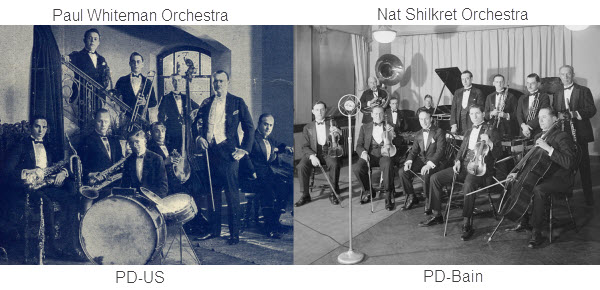
Jazz
Jazz music began in the early 1900s within the blackness community in New Orleans. Information technology was a new type of music that combined European and African styles. Information technology is a hard way to define as information technology incorporates several unlike elements of several dissimilar styles, relies on a lot of improvisation and syncopated rhythms and is subjective in many means. Jazz music reached the mainstream in the 1920s when Southern African American musicians began moving up to Chicago looking for work. The Twenties are often called the Jazz Age because the popularization of Jazz music had an enormous cultural effect. Jazz music was of import because it influenced manner, dances, accepted moral standards, youth culture, and race relations. Jazz music was one of the outset types of music to be culturally appropriated past the American white middle form and Jazz scholars often dissever the music into "Jazz" and "White Jazz," marker a difference in manner and significant between original African American jazz artists and popularized white jazz artists. Jazz music was popular on the newly booming radio networks and it was 1 of the ways that white musicians appropriated and popularized the music as many national stations refused to play records past black artists at the time. Two predominant black artists that had popularity and played in jazz bands were Louis Armstrong and Knuckles Ellington, one influential white jazz creative person at the time was Bix Beiderbecke. Jazz gained popularity and spread through the country in clubs, speakeasies, and dance halls where Jazz bands would play their new music. Many of the clubs were segregated and would only let white bands in white clubs and black bands in black clubs. Some popular African American bands playing in white clubs where black patrons were non allowed. There were very few integrated clubs around and they were called "Black and Tan" clubs. The near famous jazz musician of the decade and possibly of all time was Louis Armstrong. Armstrong was a popular African American jazz musician who played the trumpet and cornet and was known for his distinct and gravelly singing voice. Armstrong's talent helped him break down some of the racial barriers of the fourth dimension as he played in several mixed race bands and was invited to play in white merely clubs. Some of Armstrong'south notable hits from the decade included "Heebie Jeebies" from 1926, "Westward Finish Blues" from 1928, and "Ain't Misbehavin'" from 1929. Some other influential Jazz musician from the Jazz Age was Duke Ellington. Ellington was a jazz band leader and a pianist. He was an influential effigy in the jazz community but he as well did a lot for general pop music and dance music. He was as well a popular figure who frequented whites only jazz clubs to perform. A couple of Duke Ellington's popular songs from the 1920s were "Creole Love Call" and "Black and Tan Fantasy" both recorded in 1927. A 3rd influential jazz musician of the decade was a white cornetist and pianist named Bix Beiderbecke. Beiderbecke'southward style assorted with Armstrong and he is thought to have had an equal influence on the early jazz scene like Armstrong. Many jazz authorities say that two distinct styles of jazz were formed from the 1920s, and the two styles tin can be traced to the original styles of either Louis Armstrong or Bix Beiderbecke. Armstrong was a highly trained musician and was considered a virtuoso, while Beiderbecke was self-taught and therefore had an unusual style. Jazz was the defining audio and style of the 1920s and has continued to exist a pop art grade that has a constantly changing musical mural. Beiderbecke'south famous recordings included 1924'south "Riverboat Shuffle" and 1925's "Davenport Blues."
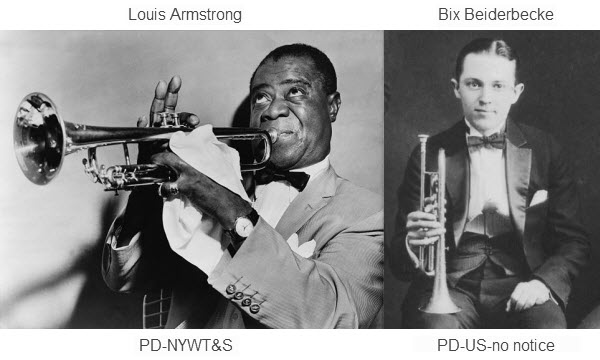
The Blues
The first popular dejection music began actualization in the late 1900s and early on 1910s. Dejection music likely originated before than that in the African American communities in the Deep Southern states of the US. Blues music is characterized by repeating chords and 1920s blues focused on a twelve bar structure. Songs would often chronicle the singers personal troubles and the daily racial bug associated with existence African American in the prejudiced and segregated South. Some blues songs were also witty and comical, a satirical have on a melancholy life. During the Twenties, blues was virtually exclusively played past black musicians and was only popular within the blackness customs. 1 of the almost important blues singers of the decade was Mamie Smith. Mamie Smith is credited with making the first recorded blues vocal performance by an African American singer in 1920. The vocal was called "Crazy Dejection" and information technology was hugely pop with an African American audience, helping to create a market for "race records," recordings that were specifically marketed to a black audience. Another important blues singer from the 1920s was the "Mother of Dejection," Ma Rainey. She was also one of the first professional blues recording artists and was known for having a powerful voice. Rainey was suspected by many to be bisexual or lesbian and is thought of equally one of the first influential voices in the LGBTQ community equally many of her songs openly referenced lesbianism. Some famous Ma Rainey songs include 1924's "See Encounter Passenger," 1927'southward "Black Bottom," and 1928's "Prove It on Me." While Ma Rainey was the "Female parent of Blues" another artist, Bessie Smith, was considered the "Empress of Dejection" in the 1920s. Bessie Smith was one of the highest paid African American performers of the decade and had several blues hits during the twenties, including "Downhearted Blues" and "T'own't Nobody's Biz-Ness If I Do" from 1923 and "I Ain't Got Nobody" from 1926. She was known for her incredibly strong vocals. A final important figure in 1920s blues music was Blind Lemon Jefferson, a singer and guitarist who had a distinctive style that made him a hugely successful recording creative person in the early on days of the music industry. He was one of the commencement solo vocalism and guitar artists to find success in the recording industry and was thought of as an innovator. Blind Lemon Jefferson's most famous songs included "Matchbox Blues," "See That My Grave is Kept Clean," and "Black Snake Moan." Blues has remained popular since the 1920s and has changed and evolved with its ain trends over time.
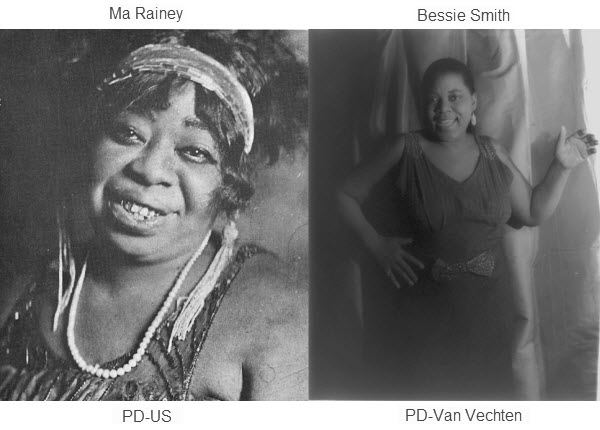
Broadway
The pic manufacture was somewhat established by the 1920s and silent films were the only types of movies around to dominate the large screen. By 1923, synchronized sound in films was making dandy strides in the development of the technology and the first short films with synchronized sound were beingness created. Past the mid to late 1920s the first full-length talking movies ("talkies"), were existence created and commercialized. With the advent of talking movies, the adjacent natural pace would exist musicals. Prior to the creation of talking films, musicals were ofttimes originated in the theatrical Broadway expanse of New York Urban center. Broadway became a place where talented performers, composers, writers, and musicians gathered to create new art together. It came into its ain during the 1920s and was a place where creativity and decadence thrived. Composers like George and Ira Gershwin, Cole Porter, and Irving Berlin flourished in their creation of musical theater. Many of these composers works were then turned into the first musical films, where they found whole new audiences across the state. Broadway music institute a home in the new synchronized sound films and America was introduced to a new and mod musical theater, a blend of classical and innovative musical styles, juxtaposed with heady stories that reflected the current era. Some examples of Broadway shows turned into musical films during the 1920s were "Sally" (1920 stage musical to 1929 film), "Rio Rita" (1927 phase musical to 1929 film), "Evidence Boat" (1927 phase musical to 1929 flick), "Sunny" and "No, No, Nanette" (both 1925 phase musicals turned into 1930 films). When musical films were non direct taken from stage musicals, they ofttimes used Broadway as a subject and back driblet, taking place in the globe of the stage. Some examples of these musicals include, "The Jazz Singer" (1928), "The Broadway Tune" (1929), "Gilded Diggers of Broadway" (1929), and "Broadway" (1929). Broadway music in the 1920s was heavily influenced past Jazz. Popular Broadway performers began making their way to the film and music recording industries where their signature performances could be chronicled and distributed to the masses through movies and records. Famous stars to sally from the Broadway scene included Fanny Brice, Al Jolson, Sophie Tucker, and Ethel Waters. Many of the early on Broadway composers were rooted in classical music, but the spirit of the decade begged for innovation and encouraged composers like George Gershwin to mix the mod with the old. Gershwin's masterpiece "Rhapsody in Blueish," introduced in 1924, perfectly melded classical with new jazz and information technology emerged the most iconic and representative song of the 1920s.
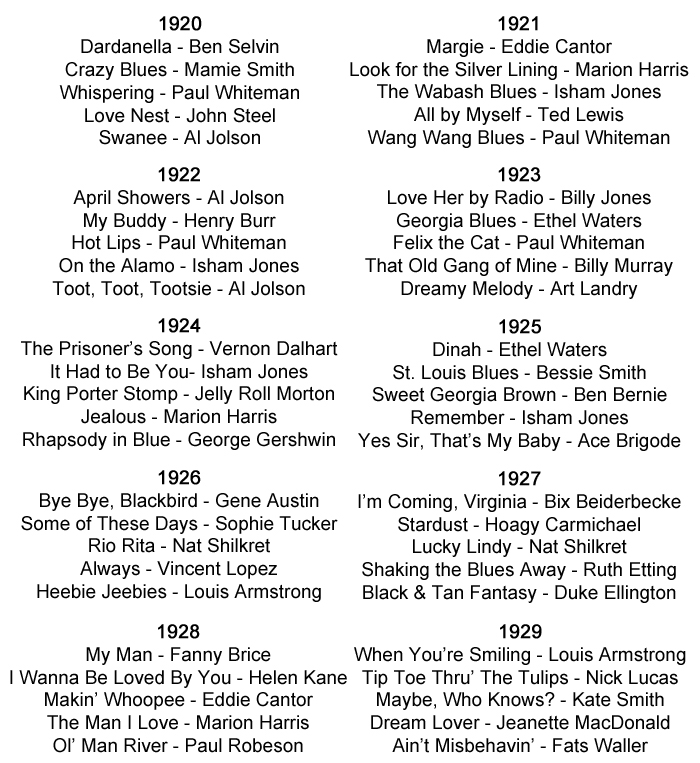
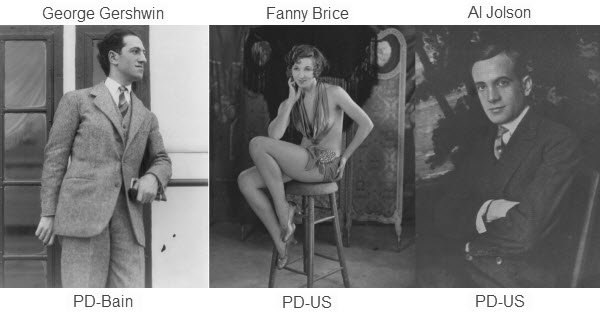
Popular Songs from the 1920'south
1920 - Dardanella - Ben Selvin, (-) Crazy Blues - Mamie Smith, (-) Whispering - Paul Whiteman, (-) Love Nest - John Steel, (-) Swanee - Al Jolson,
1921 - Margie - Eddie Cantor, (-) Look for the Silvery Lining - Marion Harris, (-) The Wabash Blues - Isham Jones, (-) All by Myself - Ted Lewis, (-) Wang Wang Dejection - Paul Whiteman,
1922 - April Showers - Al Jolson (-) My Buddy - Henry Burr (-) Hot Lips - Paul Whiteman (-) On the Alamo - Isham Jones (-) Toot, Toot, Tootsie - Al Jolson (-)
1923 - Love Her by Radio - Billy Jones (-) Georgia Blues - Ethel Waters (-) Felix the Cat - Paul Whiteman (-) That Sometime Gang of Mine - Billy Murray (-) Dreamy Melody - Art Landry (-)
1924 - The Prisoner'southward Song - Vernon Dalhart (-) It Had to Be You- Isham Jones (-) King Porter Stomp - Jelly Roll Morton (-) Jealous - Marion Harris (-) Rhapsody in Blue - George Gershwin (-)
1925 - Dinah - Ethel Waters (-) St. Louis Blues - Bessie Smith (-) Sweet Georgia Brown - Ben Bernie (-) Remember - Isham Jones (-) Yes Sir (-) That'southward My Baby - Ace Brigode (-)
1926 - Bye Bye Blackbird - Gene Austin (-) Some of These Days - Sophie Tucker (-) Rio Rita - Nat Shilkret (-) Ever - Vincent Lopez (-) Heebie Jeebies - Louis Armstrong (-)
1927- I'm Coming, Virginia - Bix Beiderbecke (-) Stardust - Hoagy Carmichael (-) Lucky Lindy - Nat Shilkret (-) Shaking the Dejection Abroad - Ruth Etting (-) Black & Tan Fantasy - Duke Ellington (-)
1928 - My Man - Fanny Brice (-) I Wanna Be Loved Past You - Helen Kane (-) Makin' Whoopee - Eddie Cantor (-) The Homo I Dear - Marion Harris (-) Ol' Human being River - Paul Robeson (-)
1929 -When You're Smiling - Louis Armstrong (-) Tip Toe Thru' The Tulips - Nick Lucas (-) Perhaps, Who Knows? - Kate Smith (-) Dream Lover - Jeanette MacDonald (-) Ain't Misbehavin' - Fats Waller"
0 Response to "What Was Fashion Like in the 1920s What Was Some Music Entertaianmnet in the 1920s"
Post a Comment